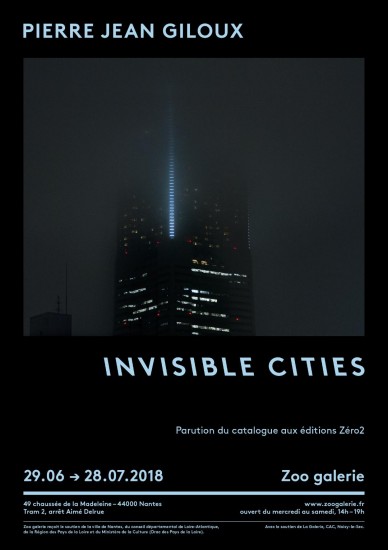 (scroll down for English text)
(scroll down for English text)
« L’art, et l’architecture en particulier, emportés comme tout le reste par le mouvement accéléré des temps modernes, soumis à l’impératif créatif d’un constant renouvellement des formes, sont tôt ou tard confrontés à la question de savoir comment hériter, non de leur histoire ou du passé en général, mais des futurs associés à des époques révolues1. »
Invisible Cities est une tétralogie de Pierre Jean Giloux qui s’inspire du mouvement architectural utopiste japonais du Métabolisme. Ce cycle de films interroge la notion de paysage urbain et rassemble plusieurs portraits de villes japonaises — Tokyo, Yokohama, Osaka, Nara, Kyoto. Il est proche de ce que l’on appelle la réalité augmentée car il superpose des images de réalités urbaines et sociales filmées et photographiées à des images virtuelles en des hybridations photographiques, vidéo et de synthèse, associées à des compositions sonores. Comme le dit l’artiste, « j’ai toujours pensé que les projets métabolistes non réalisés étaient inscrits dans le maillage réel de cette ville à la manière de spectres discrets. En les sortant de leur statut de simple projet, en leur donnant une certaine forme de vie, je transforme ces étranges architectures en laboratoires conceptuels2. »
Le premier film de la tétralogie, Metabolism, présenté à Zoo galerie, emprunte son titre au groupe d’architectes du même nom. En 1960, Takashi Asada, Kenzo Tange, Noboru Kawazoe, Masato Otaka, Fumihiko Maki, Kiyonori Kikutake et Kisho Kurokawa publièrent leur manifeste pour un nouvel urbanisme. « Après les deux bombes atomiques de 1945, il s’agissait pour ces jeunes architectes de proposer un nouveau modèle de conception architecturale. Ils n’en perpétuèrent pas moins nombre de principes de l’architecture traditionnelle japonaise, à l’aune de métaphores biologiques. Noboru Kawazoe écrivait ainsi : “nous considérons la société humaine comme un processus vital, un développement continu depuis l’atome jusqu’à la nébuleuse. La raison pour laquelle nous utilisons un tel terme biologique est que nous croyons que le design et la technologie devraient refléter la vitalité humaine”3. »
« Il était assez logique que le mouvement métaboliste, opposé au fonctionnalisme architectural et bureaucratique, trouve dans le réseau une métaphore fondatrice : celle de l’organisme, toujours construite contre celle de la machine4. »
Montrer le Japon contemporain en utilisant des formes plastiques hybrides, c’est utiliser les outils technologiques qui le constituent, dans le but de mieux le restituer. Ces villes éclectiques, laboratoires où l’architecture et l’urbanisme sont en perpétuel devenir, impliquent un dialogue entre réel et fiction. Metabolism met en scène dans un temps présent, à Tokyo, des éléments du passé qui ne furent que des projets esquissés et jamais construits, combinant des strates historiques avec un Tokyo contemporain, révélant la ville en créant volontairement de l’anachronisme… Pierre Jean Giloux a choisi pour cela deux projets relevant de la dernière utopie moderniste du xxe siècle : l’Helix City de Kisho Kurokawa (1961) dont la forme s’inspire de la double hélice de l’ADN et les Clusters in the Air d’Arata Isozaki (1960-1962) inspirés, eux, par la porte d’un temple édifié à Nara en 1203.
« Giloux, qui est passé au fil de son œuvre de la sculpture au film, du concret de la matière au virtuel des images, joue avec brio et subtilité, à l’aide des outils numériques dont dispose notre époque, de certaines techniques souvent utilisées par les cinéastes. […] Pour lui, la ville est avant tout un immense métabolisme, pas seulement une utopie architecturale japonaise défunte à laquelle on rend hommage à travers le temps, mais un véritable phénomène urbain et humain, vital. Tokyo, la plus grande aire métropolitaine planétaire, un phénomène dont l’inhumanité est toute humaine, attire une forme de surenchère. La virtuosité des mouvements de caméra, réelle dans la prise des films qui compose la base de l’action, sublimée ensuite par le montage et le travail d’addition des objets numériques, est celle d’une chorégraphie sur-réaliste5. »
1 Elie During, « À quoi rêvent les villes ? Fantômes du Métabolisme », in Pierre Jean Giloux, Invisible Cities, Zéro2 éditions, 2018, p. 39.
2 Pierre Jean Giloux in « La ville comme surface de projection », entretien avec Ingrid Luquet-Gad, op. cit. p. 128.
3 Vincent Romagny, « Réversibilité de la ville japonaise » op. cit., p. 192.
4 Pierre Musso, « Utopie urbaine et imaginaire réticulaire » op. cit., p. 82.
5 Manuel Tardits « Un monde d’apparences » op. cit., p. 6-7.
Invisible Cities
“Art, and architecture in particular, carried along like everything else by the accelerated movement of modern times and subject to the creative imperative of a constant renewal of forms, are sooner or later confronted with the question of knowing how to inherit, not their history or the past in general, but the futures associated with bygone eras.”1
Invisible Cities is a tetralogy inspired by the Japanese utopian architectural movement of Metabolism. This cycle of films by Pierre Jean Giloux questions the notion of urban landscape and brings together several portraits of Japanese cities—Tokyo, Yokohama, Osaka, Nara, Kyoto. It is close to what is called augmented reality as it superimposes images of social and urban reality, filmed and photographed, to synthetic images to produce hybridizations that are associated with sound compositions. As the artist puts it: “For my part, I’ve always thought that the unrealized Metabolist projects were part of the real gridding of that city, like discreet ghosts. By removing them from that status as mere projects, by giving them a certain form of life, I turn those strange architectures into conceptual laboratories.”2
The first film of the tetralogy, Metabolism, presented at Zoo gallery, borrows its title from the group of architects of the same name. In 1960, Takashi Asada, Kenzo Tange, Noboru Kawazoe, Masato Otaka, Fumihiko Maki, Kiyonori Kikutake and Kisho Kurokawa published their manifesto for a new urbanism. “After the two atomic bombs dropped on Japan in 1945, what was involved for those young architects was coming up with a new architectural design model. But they still embraced a number of principles undergirding traditional Japanese architecture, using the yardstick of biological metaphors. Noboru Kawazoe put it thus: ‘We regard human society as a vital process, a continuous development from atom to nebula. The reason why we use the biological word metabolism is that we believe design and technology should denote human vitality’. ”3
“It was quite logical that the Metabolist movement, which ran counter to architectural and bureaucratic functionalism, should find in the network a ground-breaking metaphor: that of the organism, invariably constructed versus that of the machine.” 4
Presenting Japan through hybrid plastic forms is using the technological tools that constitute it, with the aim of better rendering it. These eclectic cities, laboratories where architecture and urbanism are in perpetual evolution, induce a dialogue between reality and fiction. Metabolism stages in a contemporary Tokyo some elements of the past which were sketched but never built, combining historical strata with a present-day Tokyo, revealing a city by voluntarily creating anachronism… In order to do so Pierre Jean Giloux has chosen two projects from the last modernist utopia of the 20th century: Kisho Kurokawa’s Helix City (1961) whose shape is inspired by the double helix of DNA and Arata Isozaki’s Clusters in the Air (1960-1962) inspired by the door of a temple built in Nara in 1203.
“Giloux, who has proceeded throughout his œuvre from sculpture to film, from the concrete nature of matter to the virtual nature of imagery, plays both brilliantly and subtly—with the help of the digital tools which our day and age offers us—with one or two techniques that are frequently used by film-makers. […] For him, the city is above all an immense metabolism, not only a defunct Japanese architectural utopia which is paid tribute to across time, but nothing less than a vital urban and human phenomenon. Tokyo, the world’s largest metropolitan area, and a phenomenon whose inhumanity is thoroughly human, attracts a form of exaggeration. The virtuosity of the camera movements, quite real in the shooting of the films which form the basis of the plot, and subsequently sublimated by the editing and the task of adding digital objects, is that of a super-realist choreography.”5
1 Elie During, “What Do Cities Dream Of ? The Ghosts of the Metabolism”, in Pierre Jean Giloux, Invisible Cities, Zéro2 éditions, 2018, p. 47.
2 Pierre Jean Giloux, in “The city as a projection surface”, conversation with Ingrid Luquet-Gad, op. cit. p. 134.
3 Vincent Romagny, “The Reversibility of the Japanese City”, op. cit. p. 198.
4 Pierre Musso, “Urban Utopia and Reticular Imagination”, op. cit. p. 92.
5 Manuel Tardits, “A World of Appearances”, op. cit. p. 8-9.
Film produit par / Film produced by Solang Production Paris Brussels, en coproduction avec / in coproduction with S.O.I.L., Bruxelles, avec le support de / with the support of Centre National du Cinéma CNC-Dicréam, Centre national des arts plastiques CNAP, Le Carré – Centre d’art contemporain, Château Gontier (FR), Fédération Wallonie-Bruxelles FWB, Vlaams Audiovisueel Fonds VAF (BE), la Collection Pierre Darier, Cologny (CH), en partenariat avec / and in partnership with l’Ecole nationale supérieure d’architecture ENSA, Nantes (FR), Koganecho Bazaar, Yokohama, l’Institut français du Japon, et la Villa Kujoyama, Kyoto, avec / with la Fondation Bettencourt Schueller (JP).



